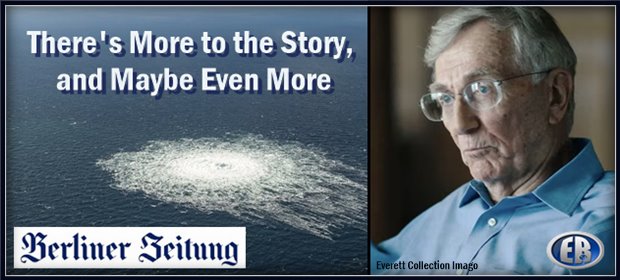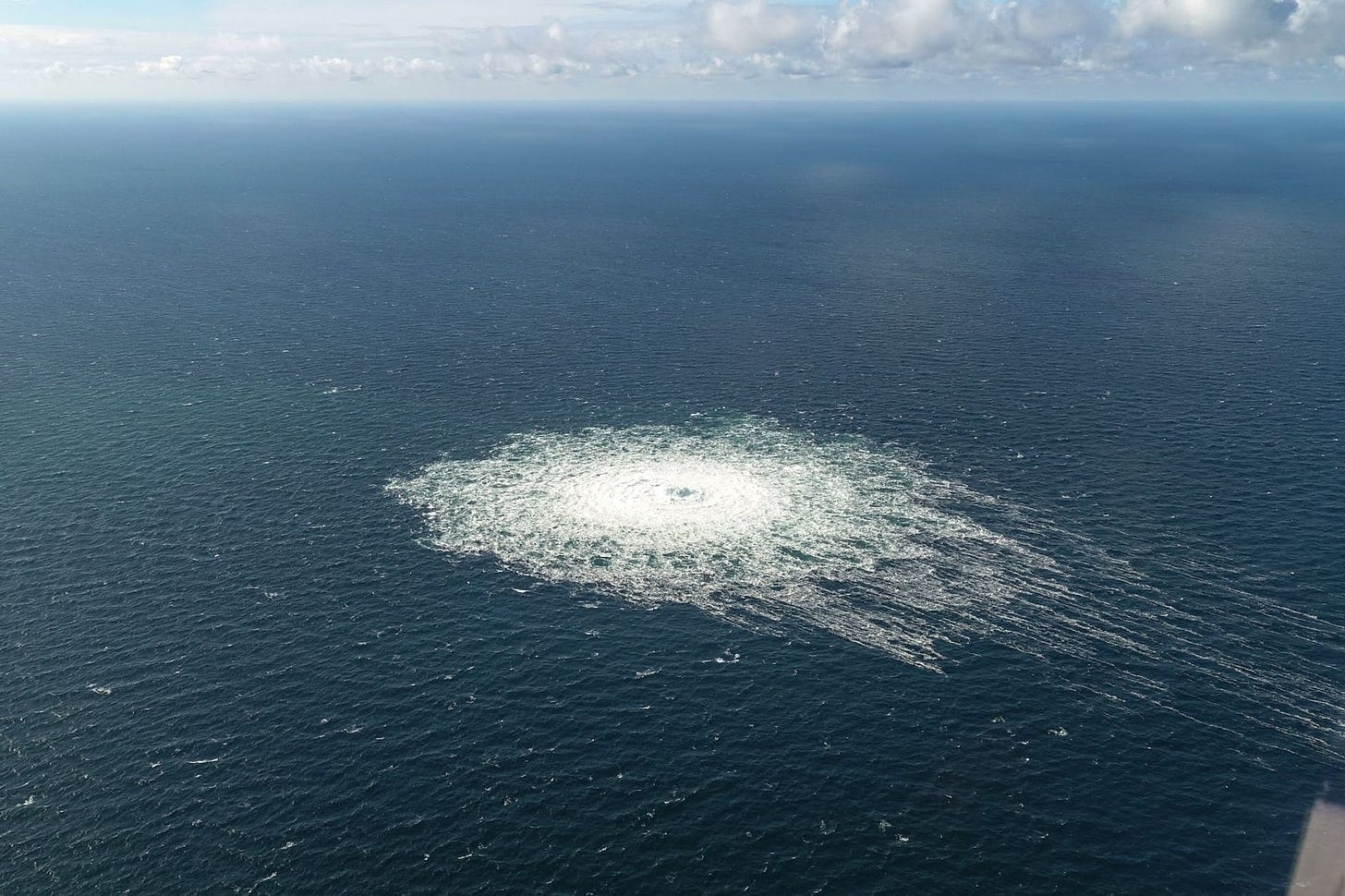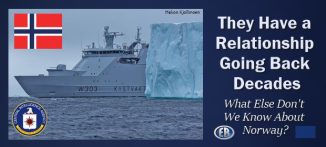
ER Editor: See this by Hersh, with a contribution by Larry Johnson —
How America Took Out The Nord Stream Pipeline

********
NORD STREAM UPDATE: In lengthy interview with the Berliner Zeitung, Seymour Hersh offers more intriguing details about his source’s account of the attack

It’s been a week since Seymour Hersh released his Substack exclusive about How America Took Out The Nord Stream Pipeline.
The mainstream German press have responded with uniform scepticism. Most reports followed the example of the wire services, in leading with the blanket denials of American officials and noting that the story was well-received in Moscow. A few operations, like the state media outlet Tagesschau, attempted a more comprehensive debunking, in this case by asking experts to pick holes in the details of Hersh’s story – with less than impressive results. The other major tactic has been to attack Hersh’s credibility, along similar lines as the American press. The latest headline here is that Bob Woodward thinks Hersh’s story is bunk, and because Woodward is also a famous American journalist, that means checkmate for Hersh, or something.
The biggest development is an interview that Hersh gave to the Berliner Zeitung (ER: browsers will translate). It was published yesterday and contains many new details. For example, Hersh tells his interviewer that the plan was to detonate “eight bombs … near the island of Bornholm in the Baltic sea,” of which only “six…went off.” This is the first confirmation we’ve had anywhere of an obvious point, namely that the operation wasn’t fully successful, and that this is the only reason that Pipe B of Nord Stream 2 escaped intact. He’s also more explicit on the involvement of Denmark and Sweden, saying “I was told that they did what they did [to facilitate the planting of explosives] and they knew what they were doing and they understood what was going on, but maybe nobody ever said ‘yes.’”
Hersh also provides more operational detail:
[T]here was a decompression chamber, and we used a Norwegian submarine hunter. Only two divers were used for the four pipelines. One problem was how to deal with Baltic Sea surveillance. The Baltic is monitored very thoroughly, there’s a lot of freely available data, so we took care of that, there were three or four different people for that. And what was done then is very simple. For 21 years, our Sixth Fleet … has been conducting [BALTOPS] … [F]or the first time in history, the NATO exercise in the Baltic had a new programme. It was to be a twelve-day exercise to drop and detect mines. A number of nations sent out mine teams, one group dropped a mine and another mine team went out to find it and blow it up.
So there was this period of time when things were exploding, and during that time the deep-sea divers could operate and attach the mines to the pipelines. The two pipelines run about a mile apart, they’re a little buried under the silt on the seabed, but they’re not difficult to get to, and the divers had practised it. It only took a couple of hours to place the bombs …
[T]hey did it towards the end of the exercise. But at the last minute, the White House got nervous. The president said he was afraid to go ahead. He changed his mind and gave new orders, so they had the ability to detonate the bombs remotely at any time. You do it with normal sonar, a Raytheon product by the way, you fly over the spot and drop a cylinder. It sends a low-frequency signal, you could say it sounds like a flute, you can set different frequencies.
The fear, however, was that the bombs wouldn’t work if they stayed in the water too long. This is actually what happened with two of the bombs. So there was concern within the group about finding the right way, and we actually had to turn to other intelligence agencies, which I’ve deliberately not written about.
There were still active explosives on the sea bed as the pipes were leaking their gas, which explains why partially complicit Denmark and Sweden closed the whole area and denied all access, until they themselves had removed everything.
Hersh also clarifies further the chronology of Biden’s order, and appears to suggest that at least some of those involved believed they were planting explosives only as part of a negotiating tactic, and that they’d never be used. (How this is to be harmonised with Hersh’s insistence that the sonar trigger was a last-minute plan, I can’t imagine):
Joe Biden decided not to blow them up back in June, it was five months into the war. But in September he ordered it done. The operational staff, the people who do “kinetic” things for the United States, they do what the president says, and they initially thought this was a useful weapon he could use in negotiations. But at some point, after the Russians invaded and then when the operation was completed, the whole thing became increasingly repugnant to the people who were doing it. These were people who worked in top positions in the intelligence services and were well trained. They turned against the project, they thought it was crazy.
Shortly after the attack, after they had done what they were ordered to do, there was a lot of anger about the operation and repudiation among those involved. That’s one of the reasons I learned so much. And I’ll tell you something else. The people in America and Europe who build pipelines know what happened. I’ll tell you something important. The people who own companies that build pipelines all know the story. I didn’t get the story from them, but I quickly learned that they know.
Elsewhere, Hersh says that the discontent with Biden’s attack is specifically within the CIA, where participants in the operation are “appalled that Biden decided to expose Europe to the cold in order to further a war he will not win.”
As I said before, it seems obvious that what happened to Nord Stream is an open secret in security and government circles, and that the truth simply can’t be acknowledged, because nobody in the German government wants to live with the political consequences. The only really interesting detail that all the debunkings have in common is their refusal to address what I see as the central problem with Hersh’s story. As I said before, he says divers planted explosives at a point where the Nord Stream 1 and 2 pipelines run just one mile apart from each other. This only describes the location of the second cluster of explosions on 26 September. The first explosion hit Pipe A of Nord Stream 2 well to the south, at a point where the two pipelines are perhaps 15 km apart.
This detail appears particularly important, in light of flight data which seems to confirm Hersh’s account that a Norwegian P8 dropped a sonar buoy into the Baltic northeast of Bornholm sometime around 4am on the morning of 26 September. Crucially, this data has the P8 arriving too late to trigger the first Nord Stream 2 explosion, which happened at 2:03 am local time. It looks for all the world like somebody organised two totally separate operations, involving two separately triggered pipeline attacks, and that Hersh’s source only knows about one of them.

••••
The Liberty Beacon Project is now expanding at a near exponential rate, and for this we are grateful and excited! But we must also be practical. For 7 years we have not asked for any donations, and have built this project with our own funds as we grew. We are now experiencing ever increasing growing pains due to the large number of websites and projects we represent. So we have just installed donation buttons on our websites and ask that you consider this when you visit them. Nothing is too small. We thank you for all your support and your considerations … (TLB)
••••
Comment Policy: As a privately owned web site, we reserve the right to remove comments that contain spam, advertising, vulgarity, threats of violence, racism, or personal/abusive attacks on other users. This also applies to trolling, the use of more than one alias, or just intentional mischief. Enforcement of this policy is at the discretion of this websites administrators. Repeat offenders may be blocked or permanently banned without prior warning.
••••
Disclaimer: TLB websites contain copyrighted material the use of which has not always been specifically authorized by the copyright owner. We are making such material available to our readers under the provisions of “fair use” in an effort to advance a better understanding of political, health, economic and social issues. The material on this site is distributed without profit to those who have expressed a prior interest in receiving it for research and educational purposes. If you wish to use copyrighted material for purposes other than “fair use” you must request permission from the copyright owner.
••••
Disclaimer: The information and opinions shared are for informational purposes only including, but not limited to, text, graphics, images and other material are not intended as medical advice or instruction. Nothing mentioned is intended to be a substitute for professional medical advice, diagnosis or treatment.






Leave a Reply